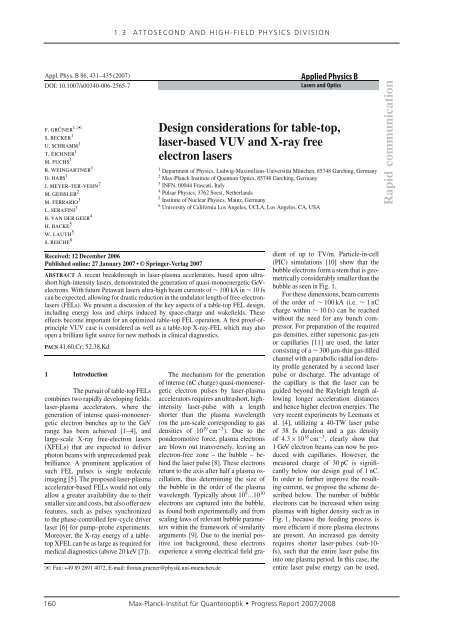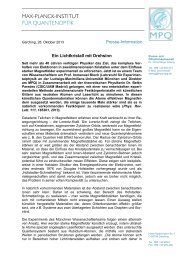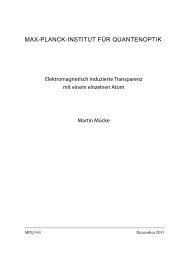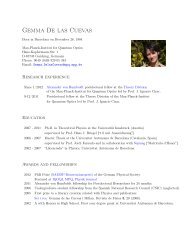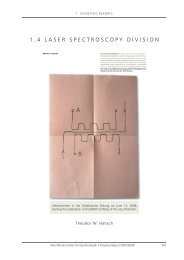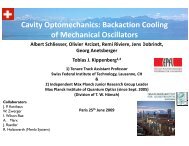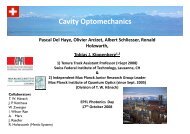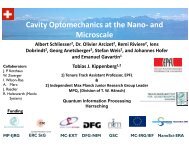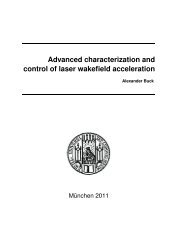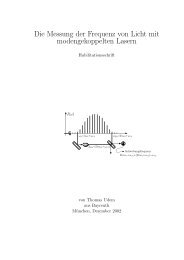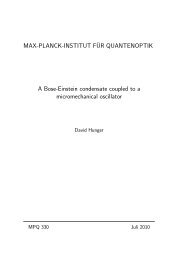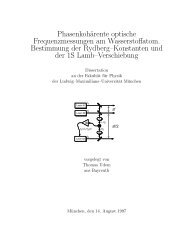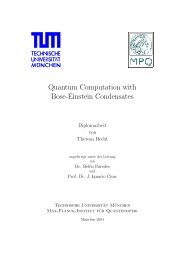Attosecond Control and Measurement: Lightwave Electronics
Attosecond Control and Measurement: Lightwave Electronics
Attosecond Control and Measurement: Lightwave Electronics
Create successful ePaper yourself
Turn your PDF publications into a flip-book with our unique Google optimized e-Paper software.
Appl. Phys. B 86, 431–435 (2007)<br />
DOI: 10.1007/s00340-006-2565-7<br />
f. grüner 1,�<br />
s. becker 1<br />
u. schramm 1<br />
t. eichner 1<br />
m. fuchs 1<br />
r. weingartner 1<br />
d. habs 1<br />
j. meyer-ter-vehn 2<br />
m. geissler 2<br />
m. ferrario 3<br />
l. serafini 3<br />
b. van der geer 4<br />
h. backe 5<br />
w. lauth 5<br />
s. reiche 6<br />
1 . 3 AT T O S E C O N D A N D H I G H - F I E L D P H Y S I C S D I V I S I O N<br />
Received: 12 December 2006<br />
Published online: 27 January 2007 • © Springer-Verlag 2007<br />
Applied Physics B<br />
Lasers <strong>and</strong> Optics<br />
Design considerations for table-top,<br />
laser-based VUV <strong>and</strong> X-ray free<br />
electron lasers<br />
ABSTRACT A recent breakthrough in laser-plasma accelerators, based upon ultrashort<br />
high-intensity lasers, demonstrated the generation of quasi-monoenergetic GeVelectrons.<br />
With future Petawatt lasers ultra-high beam currents of ∼ 100 kA in ∼ 10 fs<br />
can be expected, allowing for drastic reduction in the undulator length of free-electronlasers<br />
(FELs). We present a discussion of the key aspects of a table-top FEL design,<br />
including energy loss <strong>and</strong> chirps induced by space-charge <strong>and</strong> wakefields. These<br />
effects become important for an optimized table-top FEL operation. A first proof-ofprinciple<br />
VUV case is considered as well as a table-top X-ray-FEL which may also<br />
open a brilliant light source for new methods in clinical diagnostics.<br />
PACS 41.60.Cr; 52.38.Kd<br />
1 Introduction<br />
The pursuit of table-top FELs<br />
combines two rapidly developing fields:<br />
laser-plasma accelerators, where the<br />
generation of intense quasi-monoenergetic<br />
electron bunches up to the GeV<br />
range has been achieved [1–4], <strong>and</strong><br />
large-scale X-ray free-electron lasers<br />
(XFELs) that are expected to deliver<br />
photon beams with unprecedented peak<br />
brilliance. A prominent application of<br />
such FEL pulses is single molecule<br />
imaging [5]. The proposed laser-plasma<br />
accelerator-based FELs would not only<br />
allow a greater availability due to their<br />
smaller size <strong>and</strong> costs, but also offer new<br />
features, such as pulses synchronized<br />
to the phase-controlled few-cycle driver<br />
laser [6] for pump–probe experiments.<br />
Moreover, the X-ray energy of a tabletop<br />
XFEL can be as large as required for<br />
medical diagnostics (above 20 keV [7]).<br />
1 Department of Physics, Ludwig-Maximilians-Universität München, 85748 Garching, Germany<br />
2 Max-Planck Institute of Quantum Optics, 85748 Garching, Germany<br />
3 INFN, 00044 Frascati, Italy<br />
4 Pulsar Physics, 3762 Soest, Netherl<strong>and</strong>s<br />
5 Institute of Nuclear Physics, Mainz, Germany<br />
6 University of California Los Angeles, UCLA, Los Angeles, CA, USA<br />
The mechanism for the generation<br />
of intense (nC charge) quasi-monoenergetic<br />
electron pulses by laser-plasma<br />
accelerators requires an ultrashort, highintensity<br />
laser-pulse with a length<br />
shorter than the plasma wavelength<br />
(on the µm-scale corresponding to gas<br />
densities of 10 19 cm −3 ). Due to the<br />
ponderomotive force, plasma electrons<br />
are blown out transversely, leaving an<br />
electron-free zone – the bubble – behind<br />
the laser pulse [8]. These electrons<br />
return to the axis after half a plasma oscillation,<br />
thus determining the size of<br />
the bubble in the order of the plasma<br />
wavelength. Typically about 10 9 ...10 10<br />
electrons are captured into the bubble,<br />
as found both experimentally <strong>and</strong> from<br />
scaling laws of relevant bubble parameters<br />
within the framework of similarity<br />
arguments [9]. Due to the inertial positive<br />
ion background, these electrons<br />
experience a strong electrical field gra-<br />
� Fax: +49 89 2891 4072, E-mail: florian.gruener@physik.uni-muenchen.de<br />
dient of up to TV/m. Particle-in-cell<br />
(PIC) simulations [10] show that the<br />
bubble electrons form a stem that is geometrically<br />
considerably smaller than the<br />
bubble as seen in Fig. 1.<br />
For these dimensions, beam currents<br />
of the order of ∼ 100 kA (i.e. ∼ 1 nC<br />
charge within ∼ 10 fs) can be reached<br />
without the need for any bunch compressor.<br />
For preparation of the required<br />
gas densities, either supersonic gas-jets<br />
or capillaries [11] are used, the latter<br />
consisting of a ∼ 300 µm-thin gas-filled<br />
channel with a parabolic radial ion density<br />
profile generated by a second laser<br />
pulse or discharge. The advantage of<br />
the capillary is that the laser can be<br />
guided beyond the Rayleigh length allowing<br />
longer acceleration distances<br />
<strong>and</strong> hence higher electron energies. The<br />
very recent experiments by Leemans et<br />
al. [4], utilizing a 40-TW laser pulse<br />
of 38 fs duration <strong>and</strong> a gas density<br />
of 4.3 × 10 18 cm −3 , clearly show that<br />
1 GeV electron beams can now be produced<br />
with capillaries. However, the<br />
measured charge of 30 pC is significantly<br />
below our design goal of 1 nC.<br />
In order to further improve the resulting<br />
current, we propose the scheme described<br />
below. The number of bubble<br />
electrons can be increased when using<br />
plasmas with higher density such as in<br />
Fig. 1, because the feeding process is<br />
more efficient if more plasma electrons<br />
are present. An increased gas density<br />
requires shorter laser-pulses (sub-10fs),<br />
such that the entire laser pulse fits<br />
into one plasma period. In this case, the<br />
entire laser pulse energy can be used,<br />
160 Max-Planck-Institut für Quantenoptik • Progress Report 2007/2008<br />
Rapid communication


